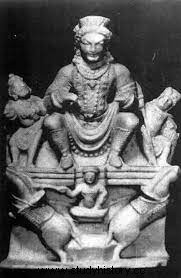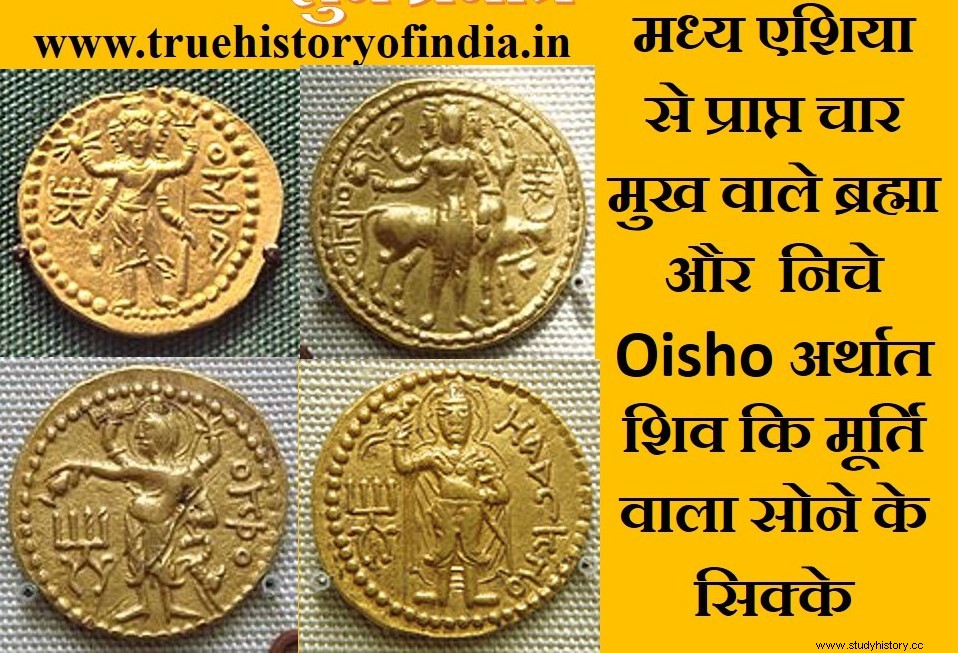The biggest flaws of modern historians are that their historical vision is limited to 3000 BC due to the Christian belief (the creation of the universe according to the Bible in 4004 BC). Beyond that, they do not have the ability to think and understand. There is also a wrong tendency among Christian-Muslim historians to deliberately deny BC and pre-Islamic history. That's why historian PN Oak writes Christian, Islamic and leftist historians as enemies of history.
On the other hand, in Indian texts, thousands of years old history is available in written form, but the "Christian" British government of India and their slave leftist historians have declared Indian texts as mythological due to their own vested interests. Therefore, when the basis itself is wrong, then the correct creation of history is not possible. Whereas taking Indian texts together, it is easy to do historical analysis and it is also factual. Vishwaguru The history of the whole of Eurasia has been distorted because of the distorted history of India.
In the first part “Secret of Sinauli Decoded” above, we saw that what we found from the excavation in Sinauli village of Baghpat district of Uttar Pradesh is similar to the culture of burial of the Shakas of Central Asia. Then we saw that the social culture of the Shakas of Central Asia is similar to the Indian cultures of Mahabharata. Now see how the mystery of history is easily solved by comparative study of the history described in Indian texts with modern historical, archaeological and ethnological researches.
Who were the Scythians?
The Shakas are mentioned in Indian literature like Ramayana and Mahabharata. Katyayan and Patanjali were also aware of the doubts. There is also mention of doubts in Manusmriti. Saka, Murund, Yavana castes are also mentioned in the Puranas. The mention of doubts is also found in many other Indian texts, such as Gargisamhita, Devichandraguptam by Visakhadatta, Harshacharita by Baan, Kavyamimansa by Rajashekhar. Detailed information about the Shakas is found in Jain texts. Did these doubts have a deep connection with India? Let's find out.
The Shakas have been related to the Vedic period of the ancient Aryans, who were called Shakas or Shakas because of their settlement on the island of Shakal. According to Indian mythological history, the countries were expelled by the mighty King Sagar (Sargon-I) and could not preserve their true history due to being destitute for a long time.
In the Puranas, the origin of this caste is said to be from the Suryavanshi king Narishyanta. King Sagar had removed King Narishyanta and exiled him from the country. Due to not following the rules of Varnashrama etc. and living separately from Brahmins, he became Mlechha. His descendants were called Shakas. (wikipedia doubt)
My opinion is that the descendants of King Narishyanta must have been called Narisyantians (like Maharashtrians, Gujaratis). Due to difficulty in pronunciation, "male" later became secondary and they came to be called "Scythian", which later became "Scythian/Scythian". In Indo-European language, "T" becomes "Th" and "Th" becomes "T". Linguists need to research this.
It is clear from the above historical facts that the culture was more or less Indian culture. Their religious beliefs and traditions were also, to be seen, Indian with some local changes. Why? Because his ancestors were Indians. In the Puranas, the origin of this Saka caste is said to be from the Indian Suryavanshi King Narishyanta, who was deposed and exiled from the country by King Sagara.
Modern scholars also believe that Central Asia was earlier famous as Shakadvipa. The people of the same Central Asia were called Sakas. They called themselves as Devputras like Indian kings, bearing the titles of Maharajadhiraja and Maharaja which are inscribed on their coins. Their subordinate kings and feudatories were called Kshatrapas, which is the Apabhramsa of Kshatriya itself.
Khas castes are a branch of doubts
Even in the ordinary graves of the Shakas, it was considered necessary to keep utensils including food and drink. This practice was also found in a branch of the Shakas from the beginning of the year to the back of the Khasas. This is proved by the Khas-Samadhis found from Ladakh to Kumaon. Ptolemy and other writers have described the khus of the Himalayas. Kash in Gilgit Chitral, Kash in Kashmir, Khashgiri in Kashgar and Khas caste from Kashmir to East Nepal and another name of Nepali language Khaskura tells this. (History of Central Asia, author-Rahul Sankrityayan)
Michael Witzel and Christopher Beckwith believe that, “the Shakyas, the clan of the historical Gautama Buddha, were originally Scythians from Central Asia, and that the Indian ethnonym ākya has the same origin as “Scythian”, called Sakas in India. (Beckwith, Christopher I. (2015). Greek Buddha:Pyrrho's Encounter with Early Buddhism in Central Asia. Princeton University Press. pp. 1–21)
Now match the description of Shakas in Indian texts with the above research. According to Indian texts, the ancestors of the Shakas were the Indian Suryavanshi king Narishyanta, who was expelled from the country by the Ichhwaku dynasty Suryavanshi King Sagar, who was the ancestor of Shri Ram and Ayodhya was his capital. King Suddhodana of Kapilvastu and his son Gautam Buddha, situated on the Indo-Nepal border, was a Kshatriya clan "Shakya" and the Shakya Kshatriyas are also considered to be of Ichchvaku dynasty (P.N. Oak). In the historical period, the Shakas were spread from the Tarim Basin of Central Asia to Nepal.
Therefore, it is clear from all this that there were Suryavanshi Kshatriyas of the Ichchvaku dynasty of Indian origin who were expelled from India for working against the Aryan (superior) culture. They settled in the Kurgan, Tarim basin, bordering India, then moved west and north from there. A branch of his Khas spread from Gilgit, Chitral, Ladakh, Kumau to Nepal, the northern frontier of India.
Let me make it clear here that our website opposes the theory of "Aryan invasion", "Aryan migration" and supports the theory of "Aryan exodus" which has been proved to be a fabricated and imperialist conspiracy of British and leftist historians. It is written in ancient texts of and which has been recognized by modern historical, ethnological and scientific researches.
religious beliefs of doubters

The supreme deity of the Shakas was Surya (as he was a Suryavanshi Kshatriya). This is not only traced from Greek books, but also the wide spread of bootlegged sun-statues like the Sakas in India and the practice of worship of the Sun god among Russians prior to their adoption of Christianity (most of the Russian races were Sakas). same descendants). Apart from Surya, Divu was the revered deity of the Shakas, which is a Vedic Dyuu. Mother Earth was worshiped in the name of Apiya (Aapya). He used to call the Sun as Swaliyu, in which the word Surya would be clearly visible after removing the extreme love of doubts with 'L' in place of 'R'. Swaliyu was the son of the deity Divu father and Apiya mother.
'Pak' was also a principal deity, who is present in the Vedas as 'Bhag' in Iranian 'Bag' (Bagdad =Bhagadatta) and 'Bog' in Russian. The king or elder chieftain was called Pakpur by the Shakas, which is a variation of Bhagpur i.e. Bhagaputra.

They initially believed in Shaivism (Wikipedia Saka). Rahul Sankrityayan, who wrote the history of Central Asia, considers the Kushanas to be a branch of the Shakas. Many other historians also consider the Kushanas to be Sakas (Wikipedia Sakas). The Kushanas were the followers of Shaivism. Rahul Sankrityayan writes in his book History of Central Asia, “It is not that the Yuchi Sakas (Kushans) after coming to India adopted Indian culture and religion, but where they belonged, that is, Hindus in the Tarim Basin of Middle-East Asia used to remain Hindus. Were." He has written the Indian word 'Rishik' for 'Yuchi'.
In the Mahabharata, there is a mention of Arjuna defeating the Rishik castes and Kambojas at the time of Digvijay and there is also a mention of Shakas and Kambojas fighting on the side of Kauravas against Pandavas in the Mahabharata war.
Language of doubt
The language of the Slavs (Russian etc.), the modern descendants of the Shakas, is still syntactic - in that suffixes in verb and word forms are used as integral parts like in Sanskrit and the use of auxiliary verbs is not seen even today. This characteristic is seen in them that in terms of language structure, the Slavic languages are as close to Sanskrit as we have no living language here. (History of Central Asia, author-Rahul Sankrityayan)
Indian linguist Veer Rajendra Rishi has found many similarities between the Indian language and the languages prevalent in Central Asia. (Indian Institute of Romani Studies at Archive.today)
Other archaeological evidence and documents from the Khotan and Tarim basins suggest that the Sakas used the Prakrit language and the Kharoshthi script. Inscriptions have been found in Chinese and Prakrit languages on coins of the first century found in Khotan, which indicate their association with China and India. (Emmerick, R. E. (14 April 1983). “Chapter 7:Iranian Settlement East of the Pamirs)
The Sakas, Kushans, Huns, Turks of Khorasan and Bahlik regions of Central Asia spoke Sanskrit-Turkish mixed languages. In these areas, the Satem language was spoken in ancient times, which can be called the ancestors of Sanskrit. We should also keep in mind that the state of Uttara Madra (Midiya), Salva and Kamboja was in Central Asia during the Mahabharata period of Bharatvarsha.
Other evidence of Shaka's association with Aryan culture
1. According to Visakha Dutt's book Mudrarakshas, after the death of Alkshendra (Alexander), the Shakas, Kambojas, Parthians and Bahliks cooperated with Chandragupta Maurya in conquering Magadha. (Mookerji, Radhakumud (1966). Chandragupta Maurya and His Times.)
Historical accounts reveal that all these were sun worshippers and pagan people who followed the Aryan culture with local changes.
2. The Indo-Scythians were named "Shaka" in India, an extension on the name Saka used by the Persians to designate Scythians. From the time of the Mahabharata wars Shakas receive numerous mentions in texts like the Puranas, the Manusmriti, the Ramayana (Balkanda), the Mahabharata, the Mahabhasiya of Patanjali, the Brhat Samhita of Vraha Mihira, the Kavyamimamsa, the Katha-Saritsagara and several other old texts. They are described as war-like tribes (Kshatriya)…( Indo-Scythians in Indian literature)
In Indian texts, he is described as Mlechha because he was exiled from India for working against Aryan (superior) culture. Due to being exiled by King Sagar, the ancestor of Shri Ram, he is also mentioned in Valmiki Ramayana as Mlechha.
3. The first of the two other great proofs that the Shakas are Indians is that the rule of the Shakas, whether across the Indus or in Gujarat, Maharashtra, Punjab, Haryana. Leaving the script, they followed the Indian civilization, culture, religion and tradition. The biggest proof of this is that British historians and leftist historians have declared Rajputs, the protectors of Indian civilization, culture, religion and tradition, as descendants of Shakas and Huns. Not only this, the national calendar of India is "Saka Samvat" run by the Shakas, which is completely Vedic calendar with some changes.
